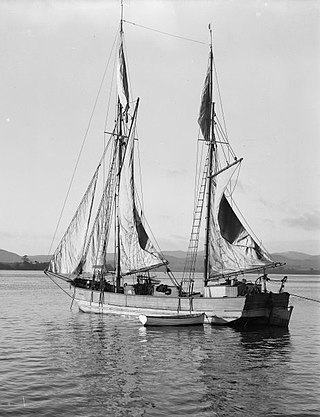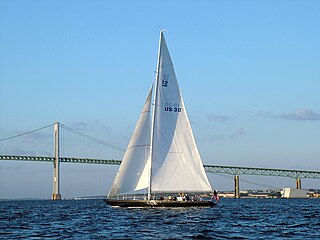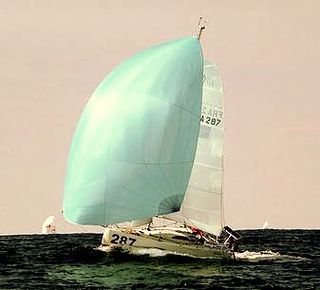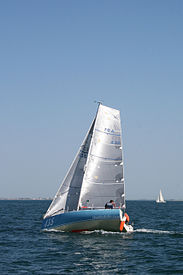
Dinghy sailing is the activity of sailing small boats by using five essential controls:

A scow is a smaller type of barge. Some scows are rigged as sailing scows. In the 19th and early 20th centuries, scows carried cargo in coastal waters and inland waterways, having an advantage for navigating shallow water or small harbours. Scows were in common use in the American Great Lakes and other parts of the U.S., Canada, southern England, and New Zealand. In modern times their main purpose is for recreation and racing; there are also garbage scows for aquatic transport of refuse.

Hobie Cat is a company that manufactures sailing catamarans, surfboards, sailboats, kayaks, stand-up paddle boards, and pedalboards as the Hobie Cat Company. It was founded in 1961 by Hobart Alter, who originally manufactured surfboards. Its line of products has included more than twenty sailing craft, plus a variety of other watercraft.

The 12 Metre class is a rating class for racing sailboats that are designed to the International rule. It enables fair competition between boats that rate in the class whilst retaining the freedom to experiment with the details of their designs. The designation "12 Metre" does not refer to any single measurement on the boat, and is not referencing the vessels overall length, rather, measures the sum of the components directed by the formula which governs design and construction parameters. Typically 12 Metre class boats range from 65 to 75 feet in length overall; they are most often sloop-rigged, with masts roughly 85 feet tall.

A canting keel is a form of sailing ballast, suspended from a rigid canting strut beneath the boat, which can be swung to windward of a boat under sail, in order to counteract the heeling force of the sail. The canting keel must be able to pivot to either port or starboard, depending on the current tack.

The IMOCA, is a 60ft development class monohull sailing yacht governed by the International Monohull Open Class Association (IMOCA). The class pinnacle event are single or two person ocean races, such as the Route du Rhum and the Vendée Globe and this has been intimately linked to design development within the class. The class is recognised by World Sailing.

The Moth is a small development class of sailing dinghy. Originally a small, fast home-built sailing boat designed to plane, since 2000 it has become an expensive and largely commercially produced boat designed to hydroplane on foils though many are still built at home, typically at much lower cost.
The A Scow is an American scow-hulled sailing dinghy that was designed by John O. Johnson as a racer and first built in 1901.

The C Scow is an American sailing dinghy that was designed by John O. Johnson as a one-design racer and first built as early as 1905. Sources disagree as to the first-built date, with claims of 1905, 1906 and 1923.

The Tempest is a trailerable, one-design racing sailboat that was designed by British naval architect Ian Proctor and first built in 1965.

A sailing hydrofoil, hydrofoil sailboat, or hydrosail is a sailboat with wing-like foils mounted under the hull. As the craft increases its speed the hydrofoils lift the hull up and out of the water, greatly reducing wetted area, resulting in decreased drag and increased speed. A sailing hydrofoil can achieve speeds exceeding double and in some cases triple the wind speed.

The Olson 30 is a sailboat designed by George Olson of Santa Cruz, CA around 1978. Olson was a surfer and surfboard shaper who decided to design a 30' ultra light displacement boat while on a delivery from Honolulu to Santa Cruz on Merlin, a 68' Bill Lee designed and built ultralight sailboat which had competed in the biennial Transpac race in 1977. During this delivery, Olson came up with the idea while sailing with Denis Bassano and Don Snyder, who lent their initials to the prototype's name, SOB 30. The resulting boat was christened Pacific High, and it was launched in 1978.

A sailing yacht, is a leisure craft that uses sails as its primary means of propulsion. A yacht may be a sail or power vessel used for pleasure, cruising, or racing. There is no standard definition, so the term applies here to sailing vessels that have a cabin with amenities that accommodate overnight use. To be termed a "yacht", as opposed to a "boat", such a vessel is likely to be at least 33 feet (10 m) in length and have been judged to have good aesthetic qualities. Sailboats that do not accommodate overnight use or are smaller than 30 feet (9.1 m) are not universally called yachts. Sailing yachts in excess of 130 feet (40 m) are generally considered to be superyachts.

The Topcat is a one-design sailing catamaran boat class which is divided into several boat sizes.

Mini Transat is a solo transatlantic yacht race which typically starts in France and ends in the Caribbean. The race uses small 6.5 metres (21 ft) long yachts conforming to the Mini Transat 6.50 class rules which gives considering scope for development More recently this has led to the formation of two divisions within the class: the production class that limits development and costs, and the prototype class which allows for more flexibility in dimensions and technology.

The C&C 37/40 is a Canadian 12.05 metres (39.5 ft) LOA fibreglass monohull sailing yacht, designed in 1988 by Robert W. Ball of Cuthbertson & Cassian as a replacement for the earlier C&C 37 dating from 1981. The C&C 37/40 is a recreational keelboat of moderate displacement, intended as a cruiser/racer or oceangoing racer. The yachts have a masthead sloop rig, with a fin keel and an internally-mounted spade-type rudder. Over 110 of the 37/40 type were built before the Canadian plant closed in 1994. The design is no longer produced.
The Archambault Coco is a French sailboat that was designed by Harlé - Mortain as a Classe Mini racer for racing in the Mini Transat 6.50. It was first built in 1985.

The Beneteau Figaro 2 or Beneteau Figaro II, officially designated as the Figaro Beneteau II, is a French sailboat that was designed by Marc Lombard as a one design, single-handed, off-shore racer for the Solitaire du Figaro race and first built in 2003. The boat and the race are named for the race's sponsor, the French newspaper Le Figaro.

The Beneteau Figaro 3, officially called the Figaro Beneteau 3, is a French hydrofoil-equipped sailboat that was designed by Van Peteghem/Lauriot-Prevost as a one design racer specifically for the Solitaire du Figaro race and first built in 2018. The boat and the race are named for the race's sponsor, the French newspaper Le Figaro.
The Melges 40 is an American sailboat that was designed by the Spanish design firm of Botin Partners as a one-design racer aimed at the European Grand Prix yacht racing circuit and first built in 2017.
























